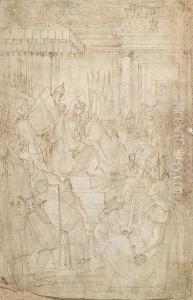Federico Sustris Paintings
Federico Sustris was an Italian painter and architect who worked primarily in Germany during the late Renaissance period. He was born around 1540 in Padua or Venice, Italy. His father, Lambert Sustris, was also a painter, and it is believed that Federico received his initial artistic training from his father.
Sustris is known to have moved to Munich, Germany, in the latter half of the 16th century, where he became closely associated with the Bavarian court. He became one of the leading artists in the service of Duke Albrecht V of Bavaria. His work in Munich included fresco decorations and designs for the Antiquarium of the Residenz, one of the largest Renaissance halls north of the Alps, which showcased the Duke's collection of antique sculptures.
In addition to his painting, Sustris made significant contributions as an architect. He was involved in the design of several important buildings in Munich, including the remodeling of the Residenz and the construction of the St. Michael's Church, a masterpiece of the early Baroque style. Sustris's architectural designs often reflected the influence of Italian Renaissance architecture, blending it with the local German style.
Sustris's works are characterized by their Mannerist style, with figures that are elongated and often placed in complex poses. He brought Italian elegance and a sense of drama to his compositions, which was somewhat atypical for the region during that time. His frescoes and paintings often depicted mythological or allegorical scenes, imbued with a sense of movement and decorative detail.
Despite his Italian origins, Sustris's work had a lasting impact on the development of art in southern Germany. He played a key role in introducing Italian Renaissance and Mannerist styles to the region, influencing subsequent generations of German artists.
Federico Sustris passed away in 1599 in Munich. While perhaps not as widely known today as some of his contemporaries, his artistic legacy is nonetheless significant for its role in the cultural exchange between Italy and Germany during the Renaissance.

